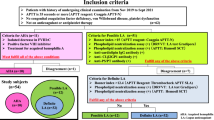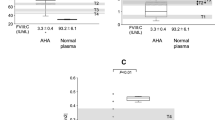Abstract
Patients with mild/moderate hemophilia (H)A, acquired HA (AHA) and lupus anticoagulants (LA), have prolonged aPTTs with low levels of factor (F)VIII activity, but the differentiation of these disorders is complex and time consuming. We established an approach to quickly differentiate these disorders using comprehensive coagulation tests. Patients’ plasmas with mild/moderate HA, AHA, LA without anti-phospholipid syndrome [LA-APS(−)], and LA with APS [LA-APS(+)] were examined using clot waveform analysis (CWA) and thrombin generation test (TGT). Activated protein C (APC) sensitivity was assessed by TGT. CWA revealed similarly prolonged clot times in all groups [NP/mild/moderate HA/AHA/LA-APS(−)/LA-APS(+); 33 ± 1/82 ± 12/116 ± 44/90 ± 29/96 ± 15 s] but significantly different decreased maximal coagulation velocity (3.1 ± 0.1/1.3 ± 0.3/0.9 ± 0.5/1.6 ± 0.3/2.2 ± 0.5). In TGT, AHA group demonstrated severely reduced peak-thrombin levels (362 ± 23/170 ± 27/49 ± 21/158 ± 75/158 ± 99 nM), whilst both LA groups markedly prolonged lag times (4.5 ± 0.3/5.0 ± 0.4/4.7 ± 0.8/12.5 ± 7.7/28.8 ± 11.8 min), suggesting that AHA could be readily identified, but the different LA sub-types failed to be classified. An APC sensitivity demonstrated that ‘normalized’ APC-induced levels of peak thrombin in LA-APS(+) were significantly lower relative to LA-APS(−) (normalized %inhibition; 5 ± 7/42 ± 39 %). Our studies confirmed that %inhibition by APC was significantly decreased in NP preincubated with purified IgGs from LA-APS(+) compared to LA-APS(−), facilitating differentiation between LA groups. A combined approach using CWA and TGT could be a useful means of differentiating coagulation disorders with prolonged aPTT.





Similar content being viewed by others
References
White GC 2nd, Rosendaal F, Aledort LM, Lusher JM, Rothschild C, Ingerslev J, et al. Definitions in Hemophilia. Recommendation of the Scientific Subcommittee on Factor VIII and Factor IX of the Scientific and Standardization Committee of the International Society on Thrombosis and Haemostasis. Thromb Haemost. 2001;85:560.
Kessler CM, Knöbl P. Acquired haemophilia: an overview for clinical practice. Eur J Haematol. 2015;95(Suppl 81):36–44.
Robertson B, Greaves M. Antiphospholipid syndrome: an evolving story. Blood Rev. 2006;20:201–12.
Baca V, Montiel G, Meillón L, Pizzuto J, Catalan T, Juan-Shum L, et al. Diagnosis of lupus anticoagulant in the lupus anticoagulant hypoprothrombinemia syndrome: report of two cases and review of the literature. Am J Hematol. 2002;71:200–7.
Oldenburg J, Pavlova A. Discrepancy between one-stage and chromogenic factor VIII activity assay results can lead to misdiagnosis of haemophilia A phenotype. Hamostaseologie. 2010;30:207–11.
Yada K, Nogami K, Wakabayashi H, Fay PJ, Shima M. The mild phenotype in severe hemophilia A with Arg1781His mutation is associated with enhanced binding affinity of factor VIII for factor X. Thromb Haemost. 2013;109:1007–15.
Tiede A, Werwitzke S, Scharf RE. Laboratory Diagnosis of acquired hemophilia A: limitations, consequences, and challenges. Semin Thromb Hemost. 2014;40:803–11.
Hoffman M, Monroe DM 3rd. A cell-based model of hemostasis. Thromb Haemost. 2001;85:958–65.
Shima M, Matsumoto T, Fukuda Y, Kubota Y, Tanaka I, Nishiya K, et al. The utility of activated partial thromboplastin time (aPTT) clot waveform analysis in the investigation of hemophilia A patients with very low levels of factor VIII activity (FVIII:C). Thromb Haemost. 2002;87:436–41.
Matsumoto T, Shima M, Takeyama M, Yoshida K, Tanaka I, Sakurai Y, et al. The measurement of low levels of factor VIII or factor IX in hemophilia A and hemophilia B plasma by clot waveform analysis and thrombin generation assay. J Thromb Haemost. 2006;4:377–84.
Shima M, Thachil J, Nair SC, Srivastava A. Towards standardization of clot waveform analysis and recommendations for its clinical applications. J Thromb Haemost. 2013;11:1417–20.
Berntorp E, Salvagno GL. Standardization and clinical utility of thrombin generation assays. Semin Thromb Hemost. 2008;34:670–82.
Matsumoto T, Nogami K, Shima M. A putative inhibitory mechanism in the tenase complex responsible for loss of coagulation function in acquired haemophilia A patients with anti-C2 autoantibodies. Thromb Haemost. 2012;107:288–301.
Okuda M, Yamamoto Y. Usefulness of synthetic phospholipids in measurement of activated partial thromboplastin time: a new preparation procedure to reduce batch difference. Clin Lab Haematol. 2004;26:215–23.
Kasper CK, Aledort LM, Aronson D, Counts R, Edson JR, van Eys J, et al. A more uniform measurement of factor VIII inhibitors. Thromb Diath Haemorrh. 1975;34:869.
Miyakis S, Lockshin MD, Atsumi T, Branch DW, Brey RL, Cervera R, et al. International consensus statement on an update of the classification criteria for definite antiphospholipid syndrome (APS). J Thromb Haemost. 2006;4:295–306.
Matsumoto T, Nogami K, Ogiwara K, Shima M. A modified thrombin generation test for investigating very low levels of factor VIII activity in hemophilia A. Int J Hematol. 2009;90:576–82.
Liestøl S, Sandset PM, Mowinckel MC, Wisløff F. Activated protein C resistance determined with a thrombin generation-based test is associated with thrombotic events in patients with lupus anticoagulants. J Thromb Haemost. 2007;5:2204–10.
Solano C, Zerafa P, Bird R. A study of atypical APTT derivative curves on the ACL TOP coagulation analyser. Int J Lab Hematol. 2011;33:67–78.
Devreese K, Peerlinck K, Hoylaerts MF. Thrombotic risk assessment in the antiphospholipid syndrome requires more than the quantification of lupus anticoagulants. Blood. 2010;28(115):870–8.
Nojima J, Iwatani Y, Ichihara K, Tsuneoka H, Ishikawa T, Yanagihara M, et al. Acquired activated protein C resistance is associated with IgG antibodies to protein S in patients with systemic lupus erythematosus. Thromb Res. 2009;124:127–31.
Ames PR, Graf M, Archer J, Scarpato N, Iannaccone L. Prolonged activated partial thromboplastin time: difficulties in discriminating coexistent factor VIII inhibitor and lupus anticoagulant. Clin Appl Thromb Hemost. 2015;21:149–54.
Acknowledgments
We would like to thank Ms. Kana Sasai and Arisa Takenaka for special technical assistant.
Author information
Authors and Affiliations
Corresponding author
Ethics declarations
Conflict of interest
All authors declare that they have no conflicts of interest.
Funding
This work was partly supported by a Grant-in-Aid for Scientific Research (KAKENHI) from the Ministry of Education, Culture, Sports, Science and Technology (MEXT) to K.N (Grant No. 15K09663).
About this article
Cite this article
Matsumoto, T., Nogami, K. & Shima, M. A combined approach using global coagulation assays quickly differentiates coagulation disorders with prolonged aPTT and low levels of FVIII activity. Int J Hematol 105, 174–183 (2017). https://doi.org/10.1007/s12185-016-2108-x
Received:
Revised:
Accepted:
Published:
Issue Date:
DOI: https://doi.org/10.1007/s12185-016-2108-x




